Combat Flight Simulator 2: WWII Pacific Theater Preview
We take this year's only WWII Pacific theater flight sim out for a spin.
"Scratch one flattop. Dixon to carrier, scratch one flattop!" These were the excited words of dive-bomber squadron leader Lieutenant Commander R.E. Dixon, reporting the sinking of the Japanese carrier Shoho at the Battle of the Coral Sea, 7 May 1942.
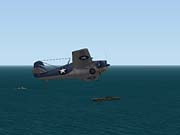
Zeros, Corsairs, and Hellcats. Dive bombers and torpedoes. Cat-and-mouse searches across the wide Pacific Ocean. And best of all, carrier landings! On the face of it, World War II in the Pacific seems like a compelling subject for a flight simulation. So why is it that you have to go back six years to find any good ones, like 1942: The Pacific Air War by Microprose, or even two years before that, to Dynamix's legendary Aces of the Pacific? The Pacific theater has been ignored for too long. Now, Microsoft is coming to the rescue with Combat Flight Simulator 2. Whereas its predecessor dealt with the crowded skies over Europe, Combat Flight Simulator 2 has set its sights on the wide-open spaces of the Pacific.
Microsoft is taking aim at several key areas in its sequel to the best-selling combat flight sim of 1998. Most of them can be summed up in one word: detail. The aircraft models are far more detailed and realistic than in the original Combat Flight Simulator. The textures are very impressive, and they exhibit great "weathering" effects. These are probably the best WWII aircraft models in a simulation to date. This detail extends to damage effects, which are now shown for various levels of physical damage to the aircraft. Fire effects are much better as well.
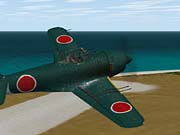
The downside to great graphics, of course, is that you need a powerful system to enjoy them to their full extent. Flight Simulator 2000 is an excellent example of a game that looked great but slowed many computers to a crawl. For Combat Flight Simulator 2, Microsoft is making a determined effort to optimize the code as much as possible so that you don't need a top-of-the-line processor and graphics card to play the game. According to Microsoft, "Frame rate is one of our major concerns for Combat Flight Simulator 2 already, but the work is not finished yet. Changes to generate further improvements to both maximum frame rate and frame rate consistency are still being made - we have committed full-time development and testing resources with the sole responsibility of optimizing performance." Because of the incomplete nature of the beta, it would be premature (and not very helpful, considering what could change in the next few months) to evaluate the game's frame rate at this point, but it's nice to know Microsoft acknowledges that many gamers don't have the latest hardware and that code optimization is necessary and important. With luck, a well-optimized final release will win Combat Flight Simulator 2 a spot on many more hard drives than just those attached to last week's newest processors.
The terrain in the Pacific involves a lot of... water. Nonetheless, the terrain textures look very good, with realistic-looking water and nice jungle and beach textures. Some terrain textures load improperly at this time, so the effect should be even better once the bugs have been ironed out. The terrain engine is a modified version of the one in Flight Simulator 2000, and the integration of this into a Pacific game is a technical challenge. The way in which coastlines are drawn is particularly troublesome in terms of processing power, so a lot of work is going toward revamping the routines necessary to display the many islands that will feature prominently in the game.
Details
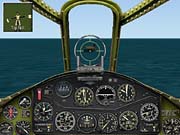
The aircraft interiors are similarly detailed, with both a 2D clickable cockpit as well as a 3D version. The cockpits are better-looking than in CFS, and the view from inside displays both moving control surfaces, such as ailerons or even folding wings, and damage to the aircraft. There is also a heads-up display in the 3D "virtual cockpit" view, as the gauges and indicators in this view can be very difficult to read. In the Japanese cockpits, the labels are even done in Japanese, although as is standard in all of Microsoft's Flight Simulator products, there are various aids, like tool tips, for navigating the control panels. There is also a small pop-up window that displays flight plan information to keep players from getting lost in the wide expanse of blue water that dominates the game.
The sound is as detailed as the graphics, and the combination of radio messages, engine noises, and weapons effects make Combat Flight Simulator 2 very immersive. One excellent touch is the inclusion of full-force feedback support, which varies in effect from aircraft to aircraft. Thus, the Zero responds to the recoil of its guns much differently than the Corsair does.
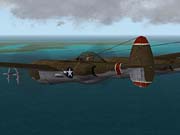
No Pacific war sim would be complete without the inclusion of carrier takeoffs and landings, and Combat Flight Simulator 2 makes them a challenge. Rather than re-create every member of the landing crew in detail on the carrier deck (like Digital Integration did in Super Hornet), the landing signals officer (LSO) appears in a small window in the upper left corner of the screen. An explanation of his flag signals is printed below for those who don't make carrier landings for a living. The LSO will indicate if you're coming in too fast, if your gear isn't down, or if you're too high; and if you don't correct the trouble, you'll be waved off. Pilots will have to contend with a rolling and pitching carrier deck in anything other than perfect weather.
The heart of any flight simulation is the physics governing the flight models. The current beta doesn't really allow us to test this claim, as Microsoft has stated that "aircraft performance, including flight and ground models, is not finished." This is evident from the fact that stall modeling seems problematic right now, and other aspects of aircraft flight characteristics seem rather forgiving, even on high realism settings. The original Combat Flight Simulator had very good flight models in the final product, though, so this is just a case of these features not being fully functional yet, instead of any indication of problems. The current build included the A6M2 and A6M5 Zero, as well as the N1K2-J "George" on the Japanese side; and the P-38 Lightning, F4U Corsair, F4F Wildcat, and F6F Hellcat for the Americans.
Campaign Over the Pacific
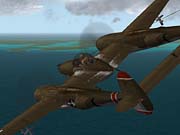
As you'd expect, Combat Flight Simulator 2 will allow single-mission flight, quick combat, free flight, and a campaign mode. There will also be a variety of training missions, but these are not in the game yet. The final game will allow players to choose from combat air patrol, fighter or bomber interception, fighter sweeps, bomber escort, search and destroy, strikes, and strafing runs. All of these flight modes were available in the original Combat Flight Simulator, but the campaign mode was the one aspect singled out most by gamers as not being up to the standard of the rest of the game. Combat Flight Simulator 2 takes great pains to replace the disappointing, linear campaigns found in the original. The current beta version has only a limited American campaign available, but the final version will let you take the part of either a Japanese or American pilot and fight through virtually the entire war (not just Pearl Harbor). Campaigns will consist of about 40 missions, but there will be many more potential missions in a campaign due to the branching structure.
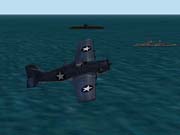
Even this expanded and improved campaign, though, won't really be fully dynamic. While there will be many branches to account for differing results in each mission, there won't be the ability to "refight" the war in the way that Rowan did for the Korean War in MiG Alley and in the way that it is trying to do in the upcoming Battle of Britain. Designer Rob Brown said at E3 that this was a conscious decision early in Combat Flight Simulator 2's development. With all the major improvements being made upon the original, to add a task like this to the design would dramatically increase production time and jeopardize the viability of the whole project. Furthermore, this kind of "virtual war" is very difficult to get right, Brown said, and troubleshooting it would have been very taxing. For this reason, you won't be able to change the outcome of the war in Combat Flight Simulator 2, even if you decisively win every mission you fly as the Japanese. Instead, the branching campaign will reflect your success locally while the war progresses toward its conclusion. All the standard features of a flight sim campaign, like medals and promotions, will be included.
In the latest beta, you're limited to starting the war at the beginning, but in the final version, you will be able to join the campaign at various points during the war. The missions start out easy, with a bomber interception, and incrementally add escorts, ships, and additional enemies. Each mission is well narrated and the voice acting is excellent, although the campaign cutscenes are not in place yet. One notable thing about narration is that it does a good job of creating a historical atmosphere in and around the game. This is one place where Combat Flight Simulator fell short. If the radio chatter is properly implemented, Combat Flight Simulator 2 will be well on the way to ditching the sterile environment of the original Combat Flight Simulator for something more in keeping with the goal of a detailed simulation. Throughout the game, the wrapper and the in-game setup screens use a retro comic-book style of art that does a good job of evoking the feel of the 1940s. Combat Flight Simulator 2 is a very stylish game.
Conclusion
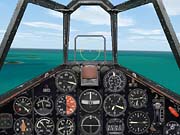
If this isn't enough, Combat Flight Simulator 2 will finally add a mission editor, which was another notable missing feature in the original. Players who are not satisfied with the choice of missions included in the game will be able to use a graphical editor to assign aircraft, targets, objectives, random events, and everything else that makes a mission unique. Further customizability comes with the familiar Microsoft feature of allowing imported aircraft and terrain from other Microsoft sims, so aircraft models and terrain from the original Combat Flight Simulator (and even Flight Simulator 2000) can be brought in to spice up the mix. Aircraft models from other Microsoft sims won't have the advanced damage display features, of course. The expandability of Microsoft's flight simulation products (and the availability of third-party add-ons) is one of the big advantages they have over competing games. There are several expansions available for Combat Flight Simulator, and Combat Flight Simulator 2 can expect similar treatment by third-party developers.
The many improvements Microsoft is making on the original Combat Flight Simulator show that the company is working to address the problems that users had with the previous product. A notable omission from the original Combat Flight Simulator was any sort of wingman command, and this did a lot to lower the sense of immersion. Combat Flight Simulator 2 will allow you to instruct your wingmen to attack, split, rejoin the formation, or help you if you end up in a jam.
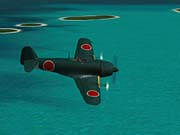
Microsoft is sparing little effort in researching Combat Flight Simulator 2. Besides drawing on the resources of several major archives, Microsoft interviewed Saburo Sakai and Joe Foss, two legendary Pacific War aces. Sakai, who with 64 kills was the highest-scoring Japanese WWII ace to survive the war, still lives in Japan, and he is more than 80 years old. Joe Foss, the highest-scoring Marine aviator in WWII, won the Congressional Medal of Honor and went on to become governor of his home state of South Dakota. Both men will be profiled in the Combat Flight Simulator 2 manual. In addition, former naval aviators Bob Campbell and Mike Weide served as authorities on US late-war carrier operations.
Combat Flight Simulator was a solid product that had to share the limelight with several outstanding WWII European theater sims, like European Air War and Jane's WWII Fighters. The Pacific War, on the other hand, is a topic that Microsoft has almost entirely to itself. By building on the experience gained with the first game, Microsoft has the opportunity to redefine the Pacific War simulation, as well as prove the viability of the hard-core, historically accurate, detailed flight simulation at a time when many companies are abandoning the genre. Microsoft expects to have Combat Flight Simulator 2 available for Christmas 2000. Judging from what we've seen so far, you might want to write an early note to Santa.
Got a news tip or want to contact us directly? Email news@gamespot.com
Join the conversation